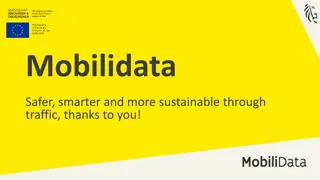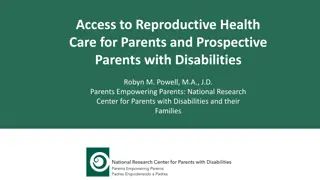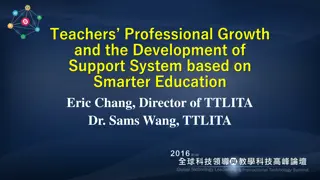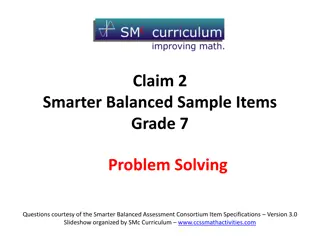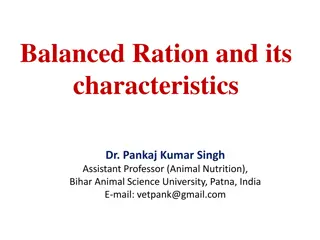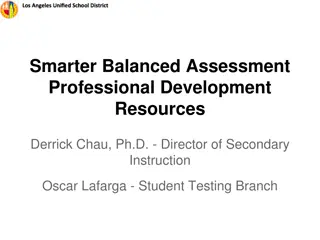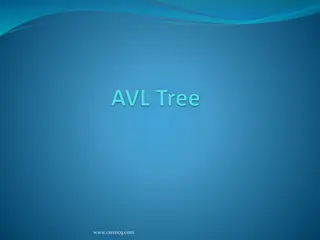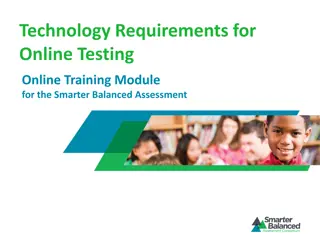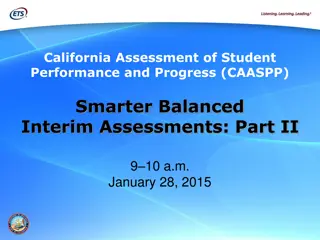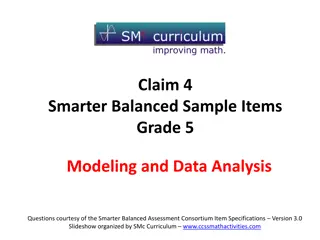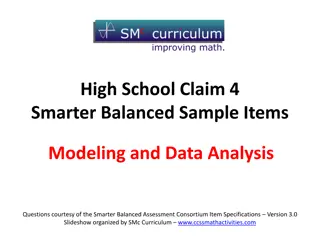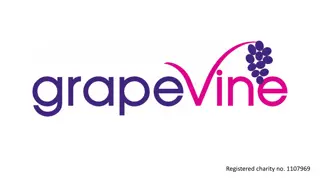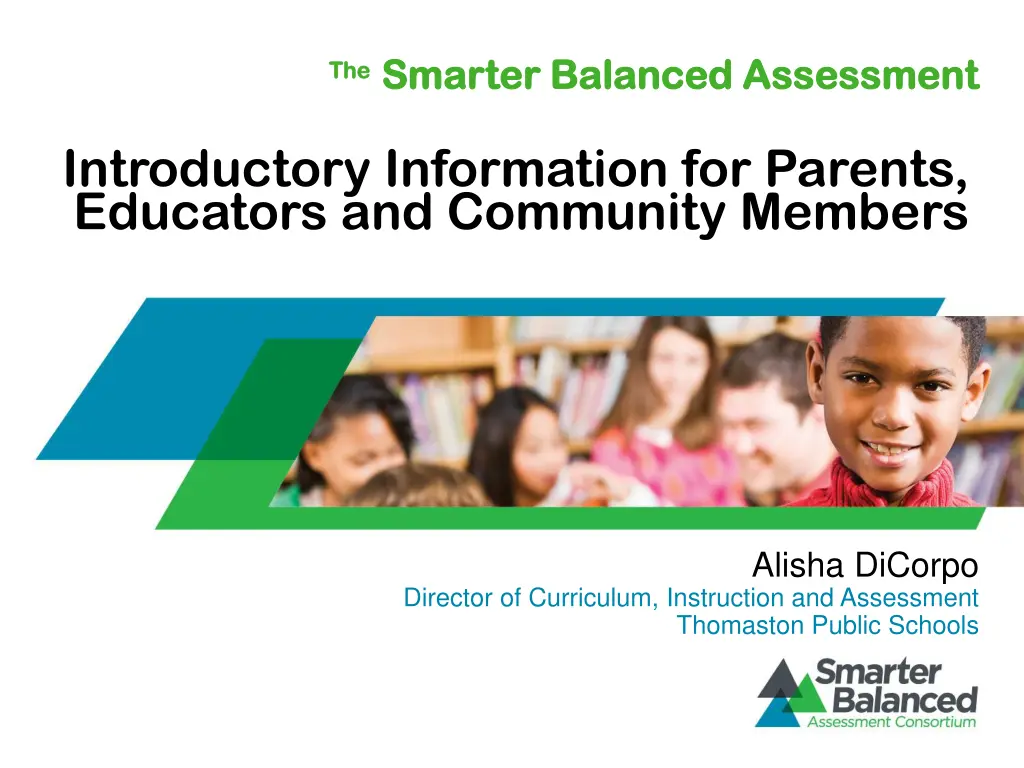
Understanding Smarter Balanced Assessments in Education
Discover the key differences between Smarter Balanced Assessments and traditional tests like CMT, including the focus on college and career readiness, use of online technologies, and balanced assessment types. Learn why Computer Adaptive Testing is special and how it enhances student measurements and test security.
Download Presentation

Please find below an Image/Link to download the presentation.
The content on the website is provided AS IS for your information and personal use only. It may not be sold, licensed, or shared on other websites without obtaining consent from the author. If you encounter any issues during the download, it is possible that the publisher has removed the file from their server.
You are allowed to download the files provided on this website for personal or commercial use, subject to the condition that they are used lawfully. All files are the property of their respective owners.
The content on the website is provided AS IS for your information and personal use only. It may not be sold, licensed, or shared on other websites without obtaining consent from the author.
E N D
Presentation Transcript
TheSmarter Balanced Assessment Smarter Balanced Assessment The Introductory Information for Parents, Educators and Community Members Alisha DiCorpo Director of Curriculum, Instruction and Assessment Thomaston Public Schools
What will be different about the new tests? Align to Career and College Readiness Standards in mathematics and English language arts/literacy Rigorously assess progress toward college and career readiness Provide achievement and growth information Use assessments that are valid, reliable, and fair for all students (Note: Alternate assessments still needed for small percentage of student) Use multiple measures of student performance Use online technologies
How will SBAC be different from CMT? Smarter Balanced CMT Content Standards Achievement Descriptors Common Core State Standards Grade-Level Expectations On Track to be Career and College Ready Prepared for Next Grade Level Learning Test Format Web-Based Pencil and Paper Item Delivery Computer Adaptive Fixed Form/Common Item Set Assessment Types Summative, Interim and Formative Summative Multiple Choice, Short Answer, Tech Enhanced, Performance Task Multiple Choice, Short Answer, Constructed response Item Types Testing Window 12 Weeks/Spring 3 Weeks/ Fall Results Turnaround Some Scores Available Immediately; Remainder in About 1 Month About 3 Months
Whats so balanced about Smarter Balanced? Summative assessments Benchmarked to CCSS; Combine Computer Adaptive and Performance Tasks Common Core State Standards specify K-12 expectations for college and career readiness All students leave high school college and career ready Teachers and schools have information and tools they need to improve teaching and learning Teacher resources for formative assessment practices to improve instruction Interim assessments Flexible, open, used for actionable feedback 4
What's so special about Computer Adaptive Testing (aka CAT)? Provides accurate measurements of student growth over time Increased precision Tailored for Each Student Item difficulty based on student responses Larger item banks mean that not all students receive the same questions Increased Security Shorter Test Length Fewer questions compared to fixed form tests Faster Results Turnaround time is significantly reduced GMAT, GRE, SAT,(ACT), Measures of Academic Progress (MAP) Mature Technology
How does a CAT work? Is the estimate as accurate as we can make it?
What is a summative assessment? Summative Assessment (Computer Adaptive) Assesses the full range of Common Core in English language arts and mathematics for students in grades 3 8 Measures current student achievement and growth across time, showing progress toward college and career readiness Can be given once a year (mandatory testing window within the last 12 weeks of the instructional year) Includes a variety of question types: selected response, short constructed response, extended constructed response, technology enhanced, and performance tasks
What role will performance tasks play? Performance Tasks Extended projects demonstrate real-world writing and analytical skills May include online research, group projects, presentations Require 1-2 class periods to complete Included in summative assessments Applicable in all grades being assessed The use of performance measures has been found to increase the intellectual challenge in classrooms and to support higher- quality teaching. - Linda Darling-Hammond and Frank Adamson, Stanford University
How long are the summative tests? ELA Mathematics (CAT and PT) Grade Total (CAT Only) 3 1:33 1:49 3:22 4 1:35 1:45 3:20 5 1:30 2:07 3:37 6 1:33 1:55 3:28 7 1:21 1:37 2:58 8 1:19 1:43 3:02
BRS Testing Schedule (Grade 3 Only) Date May 3, 2016 Day Tuesday Test Computer Adaptive ELA Length of Test 80 Minutes Testing Time 8:45-10:05am MAY 4, 2016 Wednesday Computer Adaptive ELA Makeup 80 Minutes 8:45-10:05am May 5, 2016 Thursday Computer Adaptive Math 80 Minutes 8:45-10:05am May 6, 2016 Friday Computer Adaptive Math Makeup Math Performance Task Math Performance Task Makeup 80 Minutes 8:45-10:05am May 9, 2016 Monday 60 Minutes 9:00-10:00am May 10, 2016 Tuesday 60 Minutes 9:00-10:00am
TCS Testing Schedule Date May 9, 2016 Day Monday Test Computer Adaptive Test ELA Length of Test 120 minutes Testing Time 8:45-10:45 am (4) 9:15-11:15 am (5) 9:45-11:45 am (6) May 10, 2016 Tuesday CAT ELA Makeup 120 minutes 8:45-10:45 am (4,5,6) MAY 11, 2016 Wednesday Computer Adaptive Test Math 8:45-10:45 am (4) 9:15-11:15 am (5) 9:45-11:45 am (6) 120 minutes May 12, 2016 Thursday Math CAT Makeup 120 minutes 8:45-10:45 am (4, 5,6) May 17, 2016 Tuesday Performance Task Math 120 minutes 8:45-10:45 am (4) 9:15-11:15 am (5) 9:45-11:45 am (6) May 18, 2016 Wednesday Performance Task Math Make up 120 minutes 8:45-11:45 am (4,5,6)
THS Testing Schedule (Grades 7+8 Only) Date of Test Day of Week Name of Test Duration Time of Assessme nt 8:18am- 10:02am Proctors April 28, 2016 Day 5 Thursday CAT Summative ELA 1 hour 40 minutes Grade 8 Grade 7 Long Guerrera Laus Fuller Jaskelewicz Ellis Mazzini Malo Pope Smith Henderson-Grades 7 and 8 April 29, 2016 Day 6 Friday CAT Summative ELA Make up Room 102 1 hour 40 minutes 8:18am- 10:02am May 2, 2016 Day 7 Monday CAT Summative Math 1 hour 40 minutes 8:18am- 10:02am Grade 8 Grade 7 Long Guerrera Fuller Jaskelewicz Ellis Mazzini Malo Pope Smith May 3, 2016 Day 1 Tuesday CAT Math Makeup Room 102 1 hour 40 minutes 8:18am- 10:02am Henderson-Grades 7 and 8 May 4, 2016 Day 2 Wednesda y Math Performance Task 1 hour 15 minutes 8:18am- 10:02am Grade 8 Grade 7 Long Guerrera Jaskelewicz Ellis Fuller Mazzini Malo Pope Smith May 5, 2016 Day 3 Thursday Math Performance Task Make-up 1 hour 15 minutes 8:18am- 10:02am Henderson-Grades 7 and 8
What are the English Language Arts reporting areas (aka claims )? Students can demonstrate progress toward college and career readiness in English Language arts and literacy. Overall Claim for Grades 3-8 Students can read closely and analytically to comprehend a range of increasingly complex literary and informational texts. Claim #1 - Reading Students can produce effective and well-grounded writing for a range of purposes and audiences. Claim #2 - Writing Claim #3 - Speaking and Listening Students can employ effective speaking and listening skills for a range of purposes and audiences. Students can engage in research and inquiry to investigate topics, and to analyze, integrate, and present information. Claim #4 - Research/Inquiry
What are the mathematics reporting areas (aka claims )? Students can demonstrate progress toward college and career readiness in mathematics. Overall Claim for Grades 3-8 Claim #1 - Concepts & Procedures Students can explain and apply mathematical concepts and interpret and carry out mathematical procedures with precision and fluency. Students can solve a range of complex well-posed problems in pure and applied mathematics, making productive use of knowledge and problem solving strategies. Claim #2 - Problem Solving Claim #3 - Communicating Reasoning Students can clearly and precisely construct viable arguments to support their own reasoning and to critique the reasoning of others. Claim #4 - Modeling and Data Analysis Students can analyze complex, real-world scenarios and can construct and use mathematical models to interpret and solve problems.
Does CAT have any special advantages for special students? PRECISE Unlike fixed form tests, CAT is precise at all ability levels, not just at the proficient cut score EFFICIENT Takes less items than fixed form tests to reach a valid and reliable estimate of ability, reducing testing time by as much as 50%; results are available almost immediately. RESPONSIVE & HUMANE CAT algorithm produces an individual item set for each student, adapting after each student response; item set comprised of items the student CAN and CAN T answer in equal proportion Secure and Adaptable CAT eliminates most test security concerns of fixed form tests allowing for longer test windows and small group or individualized administrations 15
But what about students who dont have much experience with computer testing? Students will have several opportunities to practice prior to the official testing: Sample items (currently available on Smarter website) Practice tests Interim assessment 16
Sample Items? Can we see some of those? Showcases the variety of item types: Selected response Constructed response Technology enhanced Performance tasks http://sampleitems.smarterbalanced.o rg/itempreview/sbac/ELA.htm 17
Where can I learn more about Smarter Balanced? On the web @ www.SmarterBalanced.org Sign up for the Smarter Balanced e-newsletter Follow the consortium on Twitter @SmarterBalanced
Questions What else would you like to know?


